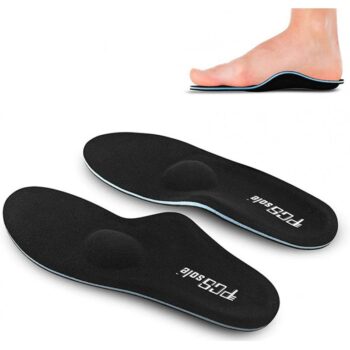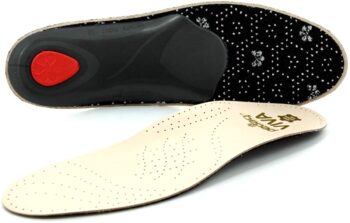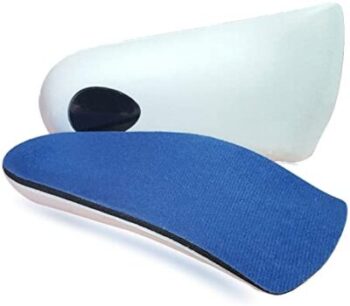Orthopedic insoles are padded inserts that are placed inside these shoes. They give back the pleasure of walking and running to people suffering from heel or foot pain. In our buying guide, we give you the right criteria to take into account as well as a list of the best orthopedic insoles of the moment.
Here is our commitment, to make sure that we provide the best user experience and content quality:
You can support us by using our links to make your purchases (at no extra cost to you)! This sometimes earns us a commission which allows us to remain independent. More about us
Our selection
"The PCSole brand is a master in the art of designing orthopedic insoles. This model is one of the most requested products."
"Here is a pair of orthopedic insoles specially adapted for flat feet. They are designed to provide maximum comfort and support."
"Are you looking for the most comfortable, strong and versatile orthopedic insoles? Look no further than Pedag Viva 187."
"With a length of 3/4, the RooRuns orthopedic insole optimizes foot comfort. It is, moreover, equipped with a cushion that relieves plantar fasciitis."

The PCSole brand is a master in the art of designing orthopedic insoles. This model is one of the most requested products.
15,18 £ on Amazon
Here is a pair of orthopedic insoles specially adapted for flat feet. They are designed to provide maximum comfort and support.
10,39 £ on AmazonOnce again, CosyInSofa designers have demonstrated their expertise in designing solid orthopedic insoles adapted to the needs of people with foot pain. Plantar fasciitis, Achilles tendonitis, shin splints and knee pain, the effects of these ailments will be lessened thanks to these particularly ingenious models. Indeed, these insoles follow the current trend and offer functions that meet a wide variety of needs.
Light, resistant and comfortable, this pair of orthopedic insoles is designed to offer maximum support while optimizing the user's comfort. This pair is intended for walkers and other people who move around quite frequently in their work. These insoles require 3 days of adaptation to generate optimal results but this can vary from one user to another. Professionals recommend changing the insoles every three months to continue to enjoy the benefits of pedestrian health.

Are you looking for the most comfortable, strong and versatile orthopedic insoles? Look no further than Pedag Viva 187.
19,96 £ on Amazon
With a length of 3/4, the RooRuns orthopedic insole optimizes foot comfort. It is, moreover, equipped with a cushion that relieves plantar fasciitis.
See the priceIdeal for everyday use, the RooRuns orthopedic insole covers 3/4 of the arch of the foot. It is the ideal solution for foot and heel conditions such as flat feet, plantar fasciitis, foot, arch and heel pain or arthritis. The EVA manufacturing material allows these insoles to be particularly effective.
Thanks to its cushion, this sole optimizes the position of your toes. This is why many hikers and athletes use these insoles in their shoes. With the RooRuns 3/4, you can forget about discomfort and discomfort in the foot. This pair is available in 3 sizes.
Any specific needs?
The best orthopedic inserts in 2021
The best entry-level orthopedic inserts
The best high-end orthopedic inserts
Your guide :
Rate this buying guide :By rating this buying guide, you are helping us to reward our best writers. Thank you!
| TOP OF THE TOP | LOW COSTS | TOP OF THE RANGE | Excellent | |

In accordance with our commitment, this buying guide does not contain any sponsored products. |
 9/10 |
 7/10 |
 8/10 |
 8/10 |
| OUR SELECTION |
PCSole Premium Eva
|
CosyInSofa The arch support
|
Pedag Viva 187
|
RooRuns 3/4
|
|
The PCSole brand is a master in the art of designing orthopedic insoles. This model is one of the most requested products.
|
Here is a pair of orthopedic insoles specially adapted for flat feet. They are designed to provide maximum comfort and support.
|
Are you looking for the most comfortable, strong and versatile orthopedic insoles? Look no further than Pedag Viva 187.
|
With a length of 3/4, the RooRuns orthopedic insole optimizes foot comfort. It is, moreover, equipped with a cushion that relieves plantar fasciitis.
|
|
|
Material(s)
|
Premium Eva Material (Soft Velvet, Cork, PU Foam)
|
Carbon fiber, Velvet, Cork
|
Soft leather
|
Eva
|
|
Size
|
35/36 EU
|
36/39 EU
|
39 EU
|
36-38 EU
|
|
Applications
|
Heel pain, arch pain, plantar fasciitis
|
Plantar fasciitis, Achilles tendonitis, knee pain
|
Plantar fasciitis and knee pain
|
Flat feet, plantar fasciitis, knee pain, arthritis
|
|
Comfort
|
|
|
|
|
|
Color
|
Black
|
Yellow
|
Natural beige
|
Blue
|
Help us improve this table:
Report an error, request the addition of a feature to the table, or suggest another product. Thank you for your kindness!
We spend thousands of hours each year studying the major specialized websites, analyzing products of hundreds of brands and reading user feedback to advise you on the best products.
We are a product review company with a single mission: to simplify your buying decisions. Our research and testing helps millions of people every year find the best products for their personal needs and budget.
To support us you can: use our links to make your purchases (which often earns us a small commission), share our articles on social networks, or recommend our site on your blog. Thanks in advance for your support!

Some manufacturers can offer to make your insoles without making you leave your home. They propose to send you a piece of printing foam directly in a box. You are invited to put the impression of your feet in the said foam and to send the resulting impressions to make your orthopedic insoles. Unfortunately, a poor impression of the impression in the foam can incorporate your foot's dysfunctional biomechanics into the design of the insole, so without a professional or experienced podiatrist to properly position your feet in the foam, your orthotics can worsen your dysfunctional biomechanics instead of correcting them.
To get orthotics, there are two options: either get them by prescription from a podiatrist who will custom make the insoles themselves. Or buy insoles manufactured in series, generally proprioceptive insoles. The advantage of custom-made orthopedic insoles (by a podiatrist) is thatthey are reimbursable. Unlike proprioceptive insoles.
Finding the right orthotic is not always easy. It takes years of experience to learn the intricacies of making custom orthotics that meet both your functional and comfort needs. If you can't afford to have custom insoles made, choose a brand with a long history of success to increase the chances of finding the right insoles the first time you buy.
Under the age of 12-14, orthotics are only appropriate if the child's legs are not the same length and are several centimeters apart. The use of orthotics too early may compromise the proper development of the arch during adolescence. They could then generate even more imbalance.
Once
you get clarity on what you really need, think carefully about the budget you can spend on your new orthotics. This will make it easier for you to make your choice.
Replacement insoles usually last about 12 months for daily or regular use. This can be extended to several years if you have a pair of insoles that you only use occasionally.
Air them out: sweaty or wet feet? Remove insoles regularly to allow moisture trapped between the sole and the shoe to dry.
Wash them: if necessary, hand wash the insoles with a mild detergent or sports detergent and air dry before reinserting them.
Inspect: Periodically remove and inspect the soles for signs of deterioration and replace as needed.
There are 3 main types of orthopedic insoles: the classic ones, the cushioned ones and the semi-custom ones.
This type of orthopedic insoles is made from elements that are shaped to provide relief to the patient. This type of insole is designed so that it can have a direct action under the foot.
Benefits:
Disadvantages:
Who is it for?
This type of insoles is mainly for people who have drooping arches, flat and low arches or who suffer from plantar fasciitis.
This
type of orthotic insoles provide additional cushioning for extra support. They are usually made from soft materials such as gel or foam.
Benefits:
Disadvantages:
Who is it for?
Cushioned insoles are suitable for those who do a lot of walking and running, or those who suffer from foot fatigue or have shin splints.
Semi-custom insoles are a comfortable option in that they offer more customized features than the generic over-the-counter inserts you find at the drugstore or supermarket. Semi-custom inserts are also much less expensive than prescription custom inserts.
Benefits:
Cons:
Who are they for?
This type of insoles will suit people who need insoles for specific needs: people with diabetes, arthritis or other health problems.
Insoles, whether semi-custom, over-the-counter or prescription, should not replace seeing your doctor or podiatrist if you have foot problems. In fact, pain can be a symptom of other more serious conditions that may require medical attention.
At first sight, orthopaedic insoles in series do not really belong to the orthopaedic inserts. Rather, they are comfort inserts that have been specially designed to absorb the shock caused by contact with the ground. They reduce pain in the heels and at the same time relieve joints and pressure. They can be used for daily needs at work, while walking or when standing all the time. Its biggest advantage is its very affordable price.
However, the limitations of the serial orthopaedic insoles are quite discernible. On the one hand, they are a standard type and work very differently on each person. If some people feel the beneficial effect immediately, others may complain of pain in their feet before they can get used to them. Also, they do not always work with all shoes.
Another alternative is to turn to custom-made orthopedic inserts. From their name, these are insoles adapted to those who wear them. As each person's morphology is unique, the vast majority of patients ask for custom-made support. This is why complete postural examinations of the foot precede the manufacture of these insoles. In addition, they must be adapted to your morphology and can therefore be slipped into all your shoes.
Everything suggests that in the short term, these insoles ensure your comfort and the protection of your feet. In the long term, you will obtain an excellent recovery, because your joints will not be too much solicited. Their small drawbacks being that these insoles often have a rather average lifespan and their replacement cannot be done lightly, because the opinion of a doctor is always required.
American studies have shown that personalized orthopedic inserts are not necessarily more effective than over-the-counter or semi-custom inserts. This is despite their cost. The only real advantage is that personalized insoles, made on prescription, are reimbursed by the social security.
The effectiveness of orthopaedic inserts can therefore be questioned. Except for certain categories of people for whom they may be indispensable: people suffering from osteoarthritis of the knee, osteoarthritis of the hip, as well as diabetics.

To relieve foot muscles
The orthopaedic insole has a special shape that allows it to fill the gaps between the foot and the ground. Manufactured using a foot moulding technique, it perfectly fits the shape of the foot. It thus offers optimal relief for the foot muscles.
For more comfort
The orthopaedic insole creates a real comfort zone for your feet. It provides an extra soft layer between you and the ground. It provides excellent protection against being crushed by angular objects such as rocks.
To protect your feet during physical activities
During physical activities, the orthopaedic insole absorbs shocks. It protects your foot from joint and muscle pain that can be caused by an impact. It also relieves the knee, hip and back.
To compensate for uneven leg length
The wearing of orthopedic insoles is prescribed to correct a difference in leg length of more than 2 centimetres. Its thickness will compensate for this inequality of length of the lower limbs. It will also remedy the back pain generated by this inequality.
To eliminate bad smells
The orthopaedic insole is removable and washable. By removing it, your shoe benefits from excellent ventilation to avoid bad odours due to accumulated perspiration. Its cleaning guarantees a perfect hygiene to your foot.
To relieve your back
The orthopaedic insole can also relieve some back pain by exerting pressure on strategic points of the foot that are connected to the lumbar area. You will feel a great relief, it is as if a huge weight was lifted from you and you will have a much better posture afterwards.
To cure knee pain
The orthopedic insole can also correct colors in the knee. By wearing a thicker insole, you won't have to take anti-inflammatory drugs or at least decrease the dose, for a healthier healing process.
In our opinion, the best brands of insoles in 2022 are :
Edensoles is a very young American brand that is renowned for its technology that is unlike any other: dynamic customization that adapts directly to the shape of the feet. We particularly appreciate its practicality and unparalleled comfort.
This brand was established in 1991 and has quickly become a market leader in athletic shoe accessories. They offer a wide range of products including insoles, socks and shoes. We appreciate the functionality and comfort of their products.
Sidas is a world-renowned French brand created in 1975. It is particularly renowned for its innovative products: Special Innovation Award as early as 1996, OUTDOOR Awards in 2011 and ISPO Awards in 2008 and 2013. We particularly appreciate the quality and accessibility of their products.
Superfeet is a Canadian company founded in 1985. It is well known for its orthopedic insoles and shoe inserts. The insoles from this brand offer extra support to keep your feet cool from the moment you slip into your shoes until the end of the day, and we like them for that reason.
Spenco was founded in 1967 by Dr. Wayman Spence. The brand's mission is "to help people around the world achieve more comfortably". It is particularly appreciated that it produces insoles and foot care products based on medical research.
The diagram below will help you to get an idea of the typical prices for each price range (entry-level, mid-range and high-end).
However, more expensive does not necessarily mean better.
We therefore advise you to always consult our ranking before deciding, rather than blindly relying on price ranges.
Check the material of your sole.
Some insoles contain latex, so check carefully for latex allergies.
Make sure your shoes have enough room for insoles.
If
you have diabetes, you are at high risk of developing corns, calluses, and other skin lesions on your foot, which can lead to diabetic wounds if your shoes are too tight. If you must use insoles, make sure they don't cause skin damage from pressure.
Check the arches of your feet.
To
test your arches, get your feet wet and walk on a concrete sidewalk. If you see full impressions of the bottom of your feet on the concrete, you probably have flat feet. If you don't see your arch print, you have hollow feet. Choose your insoles with this in mind to get the most comfort.
Cut your soles properly.
Take
your regular insoles and use them as a pattern to cut out your orthotics. This way, you will be sure not to make a mistake with your measurements.
If possible, use hot-molded orthopedic inserts.
Hot-molding makes it easier for you to customize your insoles. To mold your insoles, put them in a preheated oven at 90° for 2 min then remove them and put them directly in your shoes to be molded. Don't hesitate to put your feet in as well. Finally, do not use a microwave oven.
The best orthopedic insole depends on your needs and budget. Read our buying guide to find out which products are the best at the moment.
It is an insole designed to align the foot and ankle in the most anatomically efficient position. They look like simple insoles, but are biomechanical medical devices that are custom made or sold in mass merchandisers and drug stores to correct a specific imbalance in the foot.
These are people who have localized foot pain, bunions, hammertoes, arch or heel pain. They are also suitable for people with leg pain, knee pain, hip pain, back pain and even neck pain.
The more you wear your orthotics, the more benefits you will get. If your daily activities vary to the extent that you change shoes, you should have a second pair of custom orthotics designed for that specific activity.
In most cases, any shoe with a removable insole will work. Simply remove the insole that came with the shoe and replace it with the custom orthotic.
Every month we help more than 1 000 000 people buy better and smarter.
Copyright © 2022 - Made with ♥ by buyingbetter.co.uk
Your reviews and buying guides 0% advertising, 100% independent!